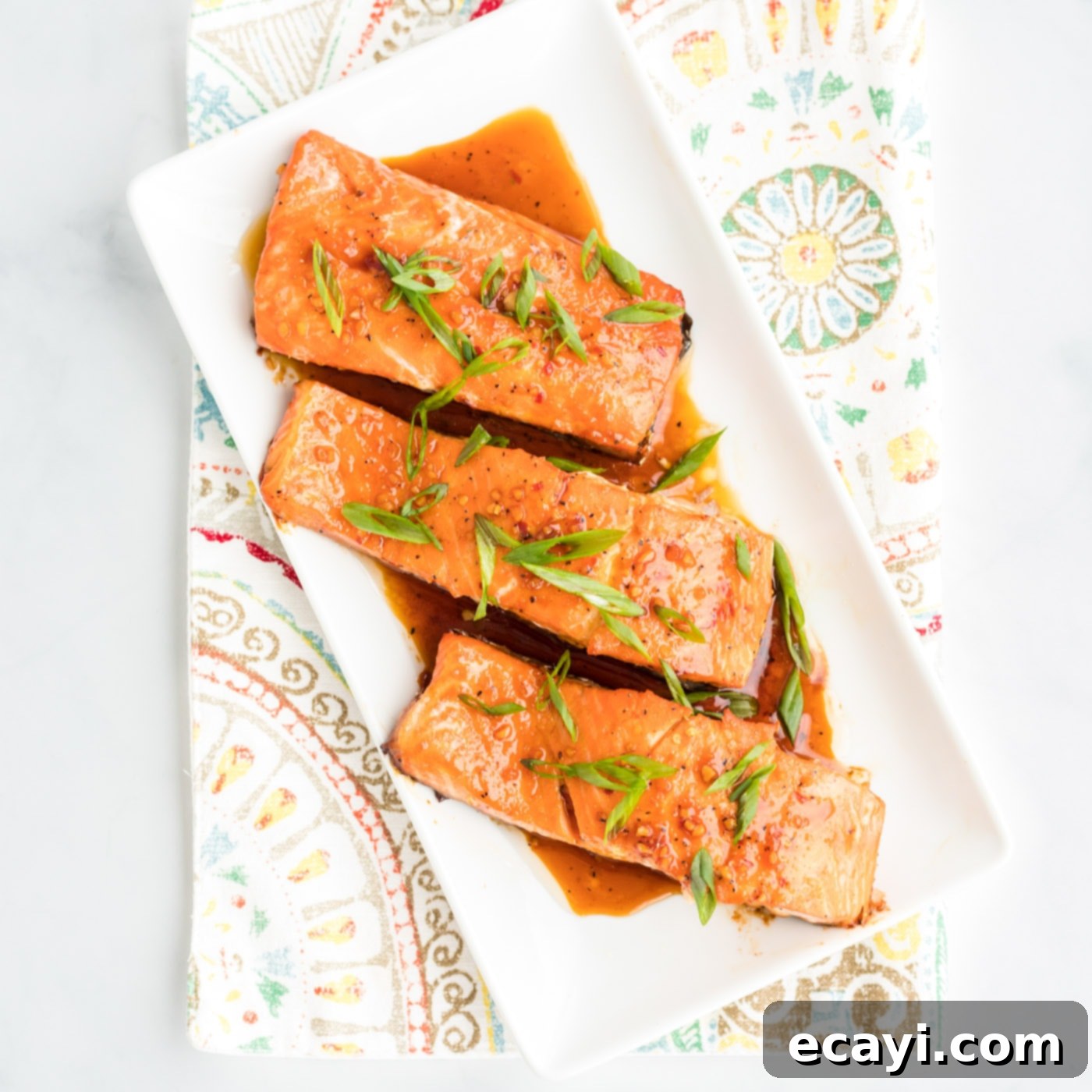Pan-Seared Maple Soy Salmon: Your Guide to a Flaky, Sweet & Savory Delight
Prepare to elevate your dinner experience with this utterly delicious and surprisingly easy Pan-Seared Maple Soy Salmon. Each succulent fillet is perfectly cooked to achieve a tender, flaky texture, then bathed in a rich, harmonious marinade. This exquisite blend of maple syrup and soy sauce creates a sticky-sweet and deeply savory glaze that will tantalize your taste buds. It’s a culinary masterpiece that strikes the perfect balance between indulgence and simplicity, making it an ideal choice for a quick weeknight meal or an impressive dish for entertaining guests.
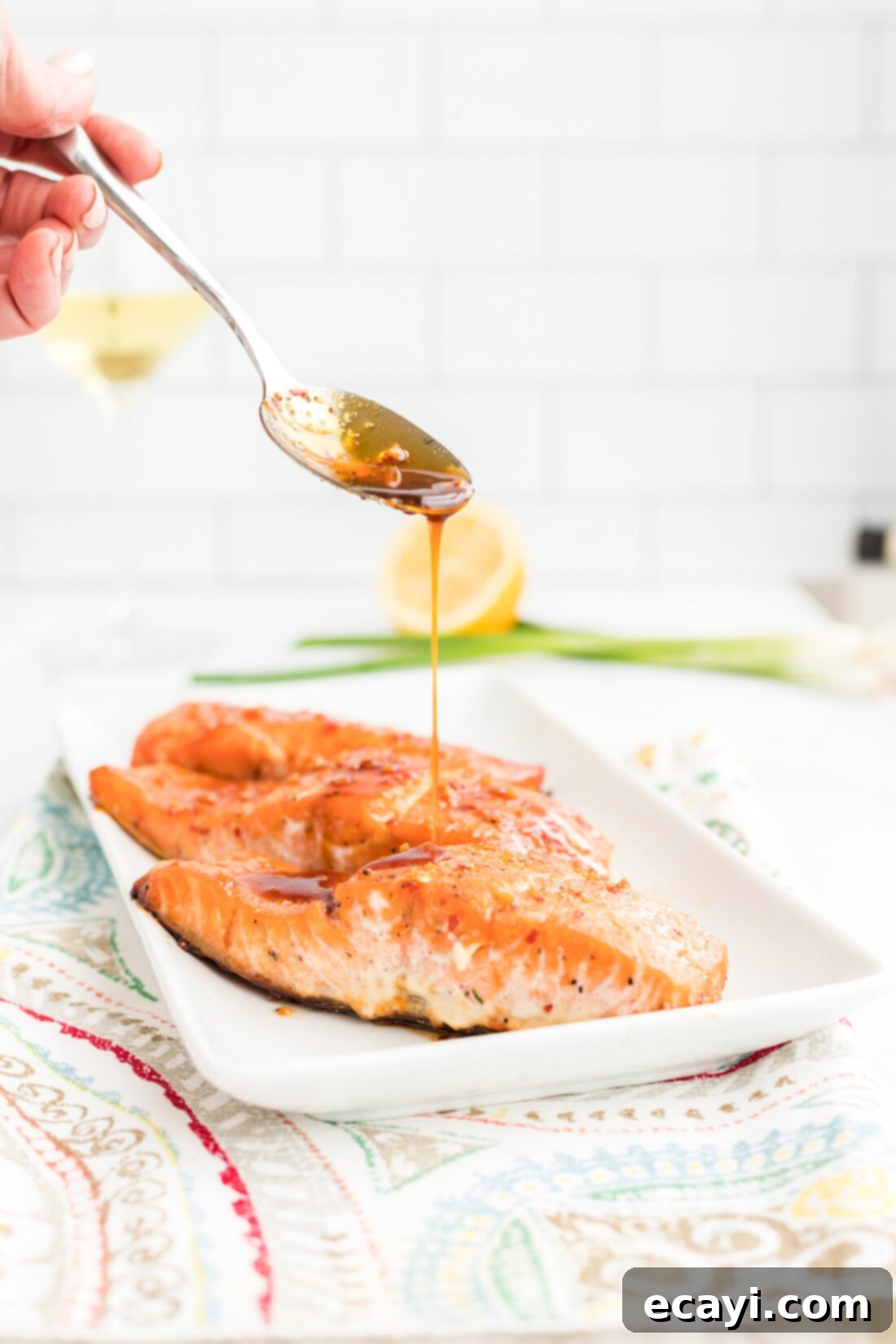
Why This Maple Soy Salmon Recipe Works Wonders
This Pan-Seared Maple Soy Salmon isn’t just another fish dish; it’s a carefully crafted flavor experience designed for maximum impact with minimal effort. The magic lies in its dynamic marinade, which transforms ordinary salmon into an extraordinary culinary delight. Here’s why this recipe deserves a permanent spot in your meal rotation:
Unforgettable Flavor Profile: Sweet, Salty, and Umami
The star of this dish is undoubtedly the robust marinade, a masterful fusion of bold soy sauce and luscious maple syrup. Soy sauce provides a complex, savory umami depth, while pure maple syrup contributes a natural, rich sweetness. This sweet-and-salty combination is not merely a contrast but a beautiful synergy, creating a glaze that caramelizes beautifully on the salmon, locking in moisture and infusing every bite with an irresistible aroma. Hints of garlic and a touch of red pepper flakes add a subtle warmth and zing, rounding out the flavor to perfection. This makes the maple soy salmon a dish that is both comforting and exciting.
Perfectly Cooked Salmon Every Time
Our method of pan-searing followed by baking ensures the salmon is cooked to absolute perfection. Pan-searing creates a gorgeously crispy skin and a beautiful golden-brown crust, locking in juices and adding a delightful textural contrast. Finishing it in the oven guarantees even cooking throughout the fillet, preventing dry edges or an undercooked center. The result is incredibly flaky, tender, and succulent salmon that practically melts in your mouth, infused with that incredible maple soy glaze. Say goodbye to dry, overcooked salmon and hello to consistently tender results.
Nutrient-Rich and Wholesome
Beyond its incredible taste, salmon is a powerhouse of nutrition. It’s an excellent source of lean protein, essential Omega-3 fatty acids, and vital vitamins like D and B12. Incorporating this healthy fish into your diet regularly can support heart health, brain function, and overall well-being. This recipe makes it easy and delicious to enjoy all the health benefits salmon has to offer, without compromising on flavor. It’s a smart choice for a balanced and nutritious meal.
Effortless Preparation for Any Occasion
Despite its gourmet taste, this maple soy salmon recipe is surprisingly simple to prepare, making it ideal for busy weeknights. With just a quick marinade and a two-step cooking process, you can have a restaurant-quality meal on the table in under an hour. Salmon is also incredibly versatile; it can be grilled, pan-seared, broiled, or baked, and pairs wonderfully with a myriad of marinades and sauces, such as the creamy lemon sauce in our popular baked salmon recipe. This particular recipe highlights salmon’s ability to absorb and complement rich, bold flavors, making it a truly multifaceted ingredient in your culinary repertoire.
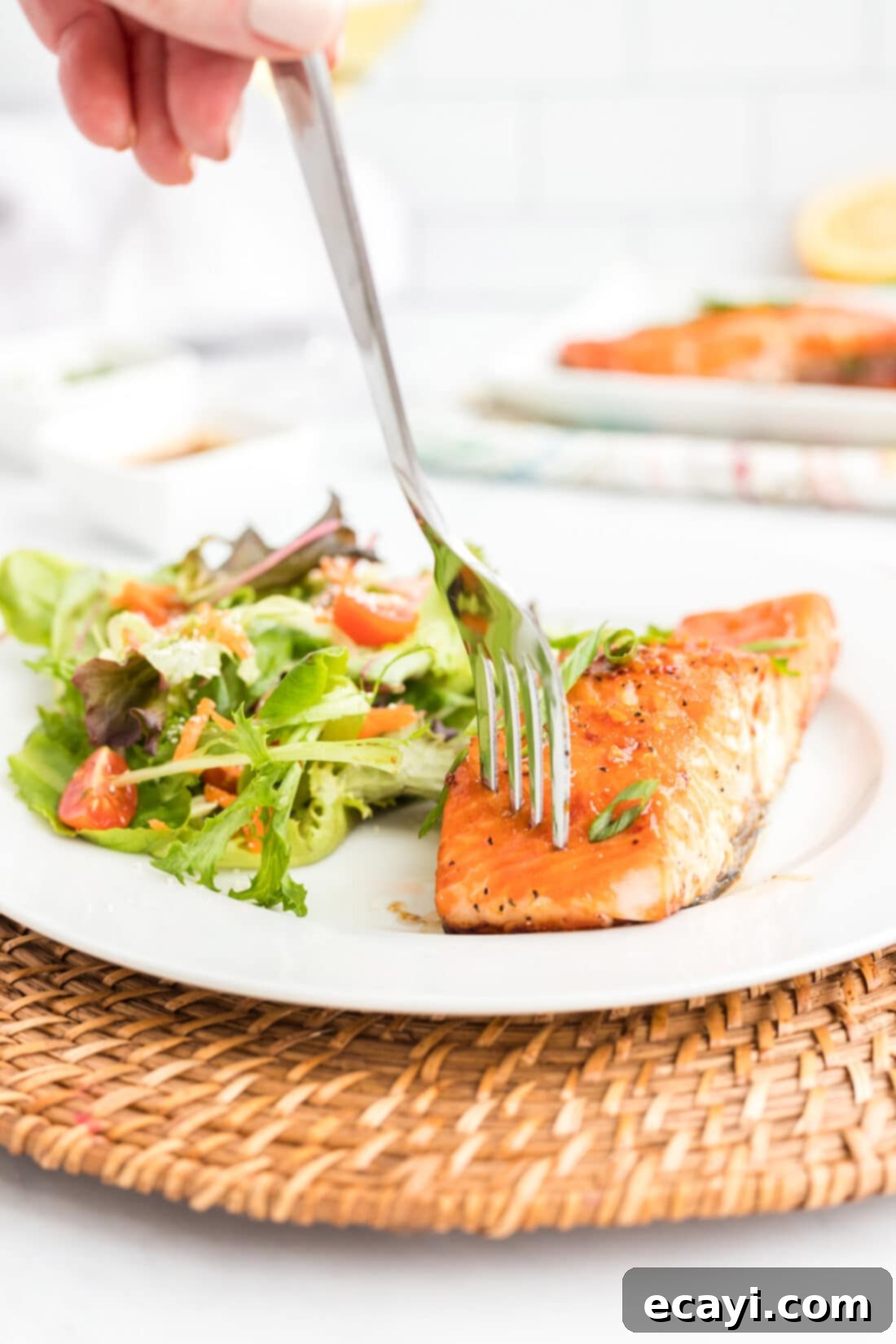
Key Ingredients for Maple Soy Salmon
Crafting the perfect Maple Soy Salmon begins with selecting high-quality ingredients. While the full list of measurements, ingredients, and detailed instructions can be found in the printable recipe card at the end of this post, here’s an overview of what you’ll need to gather:
- Salmon Fillets: The star of our show. Fresh, high-quality center-cut salmon is recommended for its consistent thickness and rich flavor.
- Olive Oil: For pan-searing, adding a light, fruity note and helping achieve that desirable crisp skin.
- Marinade Ingredients:
- Soy Sauce: The backbone of the savory element, providing umami depth. Low-sodium soy sauce is a great option to control saltiness.
- Maple Syrup: Pure maple syrup is crucial for that authentic, rich sweetness that balances the soy. Avoid artificial syrups for the best flavor.
- Garlic Salt: A convenient blend of savory garlic and salt, enhancing the overall seasoning.
- Black Pepper: Freshly ground for a pungent kick.
- Red Pepper Flakes: Adds a hint of warmth and a gentle spice, elevating the flavor profile without making it overly hot.
- Minced Garlic: Fresh garlic provides an aromatic foundation, crucial for a vibrant marinade.
- Optional Garnish: Sliced green onions or fresh parsley for a burst of color and freshness.
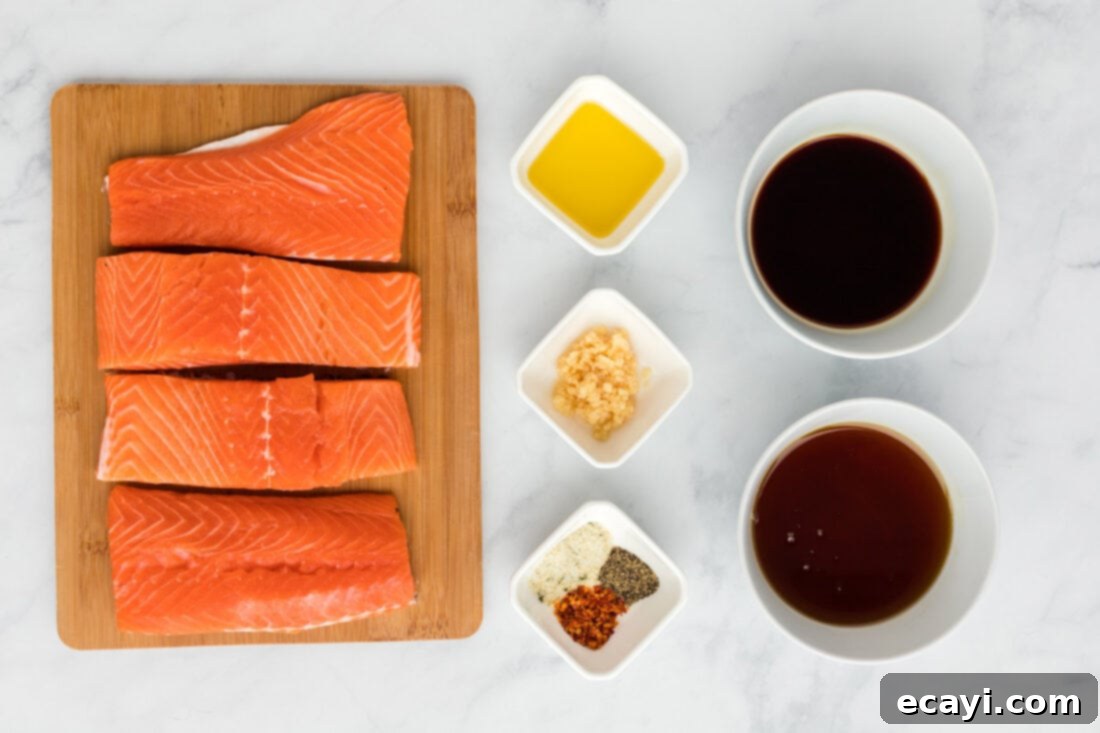
Ingredient Spotlight & Smart Substitutions
Understanding your ingredients and knowing how to make smart substitutions can transform any recipe. Here’s a deeper dive into the key components of our Maple Soy Salmon:
SALMON – Choosing the Best Fillets: For this pan-seared maple soy salmon, center-cut salmon fillets are highly recommended. Their uniform thickness ensures even cooking, leading to perfectly flaky results across all pieces. Aim for fillets weighing around 8 ounces each. While frozen salmon can be used, fresh salmon will always yield the best texture and flavor. If using frozen, remember to thaw it completely overnight in the refrigerator to prevent a watery outcome. When selecting fresh salmon, look for vibrant, moist flesh with no browning or strong fishy odor. Skin-on fillets are preferable for pan-searing as the skin helps protect the delicate flesh from overcooking and becomes wonderfully crispy. You can use various types of salmon like Atlantic, Sockeye, or Coho, each offering slightly different fat content and flavor profiles. Atlantic salmon is generally fattier and more forgiving, making it an excellent choice for this recipe.
MAPLE SYRUP – The Sweetness Factor: The quality of your maple syrup significantly impacts the final flavor. Always opt for pure maple syrup, ideally Grade A Dark Robust Taste (formerly Grade B), for its rich, caramelized notes that stand up well to the savory soy. Avoid “pancake syrup” which is often just corn syrup with artificial flavorings. If you don’t have maple syrup, good quality honey can be a suitable substitute, though it will alter the flavor profile slightly. Agave nectar could also work for a lighter sweetness.
SOY SAUCE – Umami Foundation: Soy sauce provides the essential umami and salinity. For health-conscious cooks, a low-sodium soy sauce is an excellent choice to manage the overall sodium content without sacrificing flavor. If you’re avoiding gluten, tamari is a perfect gluten-free alternative that offers a similar taste. Coconut aminos can also be used for a soy-free option, though it is slightly sweeter and less salty, so you might need to adjust the balance with a pinch more salt or a little less maple syrup.
GARLIC SALT & PEPPER – Flavor Boosters: Garlic salt offers a convenient way to add both garlic flavor and salt. If you only have garlic powder and salt separately, use ½ teaspoon garlic powder and ¼ teaspoon fine sea salt. Freshly ground black pepper is always superior to pre-ground for its aromatic qualities. A pinch of white pepper can also be used for a milder heat.
RED PEPPER FLAKES – A Touch of Heat: These add a subtle warmth that complements the sweet and savory notes. If you prefer more heat, feel free to add a little extra. For a milder dish, you can reduce the amount or omit them entirely. A dash of sriracha or a finely minced fresh chili could also be introduced for a different kind of kick.
Crafting Your Maple Soy Salmon: Step-by-Step Guide
These step by step photos and instructions are here to help you visualize how to make this recipe. You can Jump to Recipe to get the printable version of this recipe, complete with measurements and instructions at the bottom.
- Preheat Oven: Begin by preheating your oven to 375°F (190°C). This ensures it’s ready for baking once the salmon has been seared, allowing for a seamless transition and perfect cooking.
- Prepare the Marinade: In a 13×9 baking dish (or a similar shallow dish), combine all the marinade ingredients: soy sauce, maple syrup, garlic salt, pepper, red pepper flakes, and minced garlic. Whisk them thoroughly until well combined, creating that irresistible sweet and savory blend.
- Marinate the Salmon: Carefully lay your salmon fillets, skin side up, into the prepared marinade in the baking dish. Ensure each fillet is coated. Place the dish in the refrigerator and allow the salmon to marinate for a full 30 minutes. This crucial step allows the flavors to deeply penetrate the fish, resulting in a more flavorful and tender outcome. Do not marinate for much longer than 30 minutes, especially if using delicate salmon, as the acidity in the soy sauce can begin to “cook” the fish.
- Heat Skillet: While the salmon marinates, heat the olive oil in an oven-proof skillet (cast iron works wonderfully) over medium-high heat until the oil is shimmering, indicating it’s hot enough for a good sear. This is key to achieving that desirable crispy skin.
- Sear Salmon (Skin Side Up): Remove the salmon from the marinade, allowing any excess to drip off (but do not discard the marinade!). Place the fillets, skin side up, into the hot skillet. Sear for about 2-3 minutes. This initial sear on the flesh side helps to create a beautiful crust and begin the caramelization process, while the skin remains intact for the next step.
- Reserve Marinade: As the salmon sears, transfer the remaining marinade from the baking dish into a small saucepan. Set it aside; you will be reducing this into a delicious glaze.
- Flip and Brush: Carefully turn the fish over so the skin side is now down in the skillet. Immediately brush the top (flesh side) of the fillets generously with some of the reserved marinade. This adds another layer of flavor and helps create a sticky, glossy finish.
- Bake to Perfection: Transfer the skillet directly into your preheated oven. Bake for 15-20 minutes, uncovered. The exact cooking time will depend on the thickness of your salmon and your desired level of doneness. Use the tips in our FAQ section to determine when your salmon is perfectly cooked.
- Reduce Marinade to Glaze: While the salmon bakes, bring the reserved marinade in the saucepan to a gentle boil over medium-high heat, stirring occasionally. Once it reaches a boil, reduce the heat to medium-low and continue to simmer, stirring frequently. Allow it to reduce and thicken until it coats the back of a spoon, transforming into a rich, syrupy glaze. This reduction process intensifies the flavors and creates a wonderful sauce for serving.
- Finish and Garnish: Once the salmon is cooked through, remove the skillet from the oven. Generously brush each fillet with the thickened maple soy glaze. For a final flourish and a touch of freshness, garnish with thinly sliced green onions or chopped fresh parsley. Serve immediately and enjoy!
Frequently Asked Questions & Expert Tips for Maple Soy Salmon
The key to tender, flaky salmon is knowing when it’s done without overcooking. To test for doneness, gently press your finger (or the tip of a knife if it’s too hot) onto the thickest part of the fillet’s center. If it begins to flake easily or separate into layers, it is done. Avoid overcooking, which results in dry, overly flaky fish. For the most accurate reading, use an instant-read thermometer; salmon is perfectly cooked when it reaches an internal temperature of 125-135°F (52-57°C) in its thickest part. Remember, it will continue to cook slightly after being removed from the heat (carryover cooking).
Achieving crispy skin is all about preparation and proper searing. First, ensure your salmon fillets are as dry as possible before cooking; pat them thoroughly with paper towels. A dry surface is crucial for crisping. Secondly, use a good quality oven-proof skillet (cast iron is excellent for this) and preheat it well with olive oil over medium-high heat until the oil is shimmering. When you place the salmon skin-side down, resist the urge to move it for the first few minutes. Let it sear undisturbed until the skin is golden brown and visibly crisp. Our method of searing skin-side down in the hot skillet then finishing in the oven is ideal for this.
While salmon is best enjoyed fresh from the oven, you can certainly do some prep work in advance. The marinade can be mixed and stored in an airtight container in the refrigerator for up to 3-4 days. You can also slice your green onions for garnish ahead of time. However, it’s best to marinate the salmon fillets for only 30 minutes just before cooking to achieve the optimal texture and flavor. Marinating for too long can sometimes make the salmon mushy due to the acidity of the soy sauce.
Absolutely! While this recipe focuses on pan-searing for that delightful crispy skin, the maple soy marinade is incredibly versatile. For baking, place marinated salmon fillets in a baking dish (skin-side down if you prefer) and bake at 400°F (200°C) for 12-18 minutes, depending on thickness, until flaky. For grilling, place the salmon fillets skin-side down on a well-oiled grill over medium-high heat. Grill for 4-6 minutes, then flip and grill for another 3-5 minutes, brushing with the reduced glaze during the last few minutes. Always ensure an internal temperature of 125-135°F (52-57°C) for doneness.
Store any leftover maple soy salmon in an airtight container in the refrigerator for up to 2 days. To reheat, gently warm it in an oven at 275°F (135°C) for about 10-15 minutes, or until just heated through, to prevent it from drying out. Avoid microwaving if possible, as it can easily overcook the fish and alter its texture. Leftovers are also delicious cold, crumbled into salads or pasta dishes.
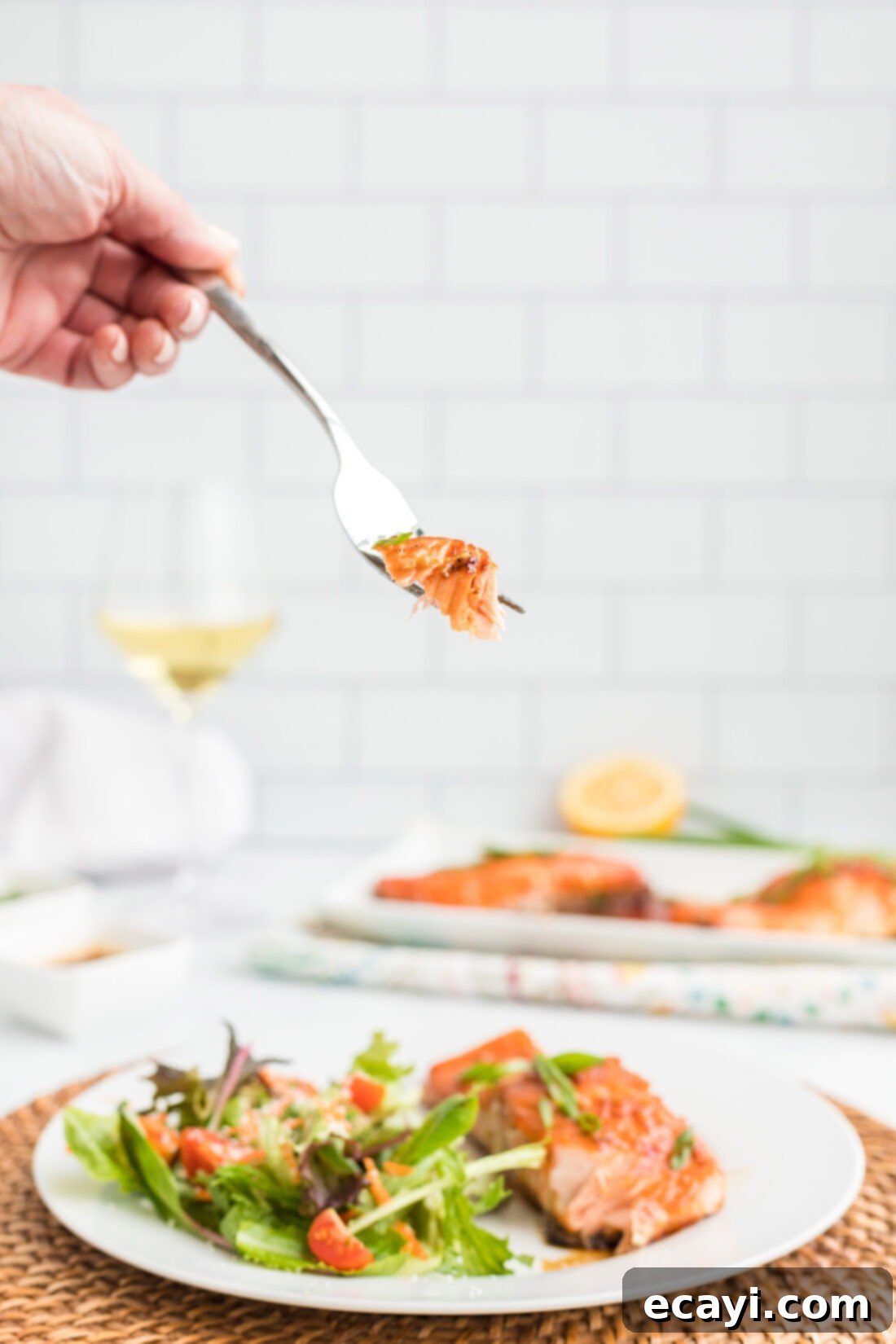
Delectable Serving Suggestions for Maple Soy Salmon
This Pan-Seared Maple Soy Salmon is a versatile dish that pairs beautifully with a variety of sides, allowing you to create a complete and satisfying meal. The sweet and savory glaze makes it a fantastic centerpiece, and these suggestions will help you build the perfect plate:
Classic Pairings: Rice and Roasted Vegetables
A bed of fluffy white or brown rice is a classic and highly recommended accompaniment. The rice soaks up the extra maple soy glaze, creating a flavorful and comforting base. Alongside, consider serving a medley of roasted vegetables. Options like crisp roasted green beans, tender broccoli florets, elegant asparagus spears, caramelized Brussels sprouts, or hearty roasted potatoes all complement the salmon wonderfully. Roasting brings out their natural sweetness and a slight char that pairs exquisitely with the rich fish.
Fresh and Light Options: Salads
For a lighter meal, serve your maple soy salmon alongside a fresh, leafy dinner salad. A simple mixed greens salad with a light vinaigrette provides a refreshing contrast to the richness of the salmon. You could also create a more elaborate Asian-inspired salad with ingredients like shredded cabbage, carrots, bell peppers, and a sesame ginger dressing to echo the flavors of the marinade.
Creative Uses for Leftovers
Don’t let any delicious maple soy salmon go to waste! Crumbled leftover salmon makes an excellent addition to a variety of dishes. Flake it into a fresh green salad for an instant protein boost, or toss it with hot pasta and a light sauce for a quick and flavorful lunch the next day. It’s also wonderful in wraps, sandwiches, or even as a topping for grain bowls.
Presentation Tip: Due to the sticky nature of the maple soy glaze, we recommend serving each fillet on its own plate to prevent it from sticking to a communal platter. However, if you’re keen on an attractive platter presentation, lay down a piece of parchment or waxed paper first. The slight stickiness of the skin side to the plate is actually a bonus for individual servings, as it makes it incredibly easy for the fish to separate from its skin, allowing for clean, delicate flakes.
Explore More Delicious Salmon Recipes
If you’ve fallen in love with the versatility and flavor of salmon, there’s a world of culinary possibilities waiting for you. From quick weeknight dinners to elegant special occasion meals, salmon is a fantastic choice. Here are some of our other favorite salmon recipes to inspire your next kitchen adventure:
- Grilled Salmon: Achieve smoky perfection with our easy grilling guide.
- Baked Salmon: A simple and reliable method for tender, flavorful results every time.
- Poached Salmon: For a delicate and moist fish, perfect for salads or light meals.
- Dijon Lemon Caper Salmon: A bright and zesty flavor combination that’s incredibly fresh.
- Sheet Pan Salmon Dinner: Your entire meal cooked on one pan for ultimate convenience and minimal cleanup.
- Cedar Plank Salmon: Infuse your salmon with an incredible smoky aroma using this classic technique.
- Lemon Salmon: Simple, elegant, and packed with refreshing citrus notes.
- Instant Pot Salmon: Fast and flavorful salmon cooked to perfection under pressure.
I absolutely adore sharing my passion for baking and cooking, along with my kitchen experiences, with all of you! Remembering to come back each day for new culinary inspiration can be tough, which is why I offer a convenient newsletter delivered straight to your inbox every time a new recipe posts. Simply subscribe today and start receiving your free daily recipes, making it easier than ever to discover your next favorite meal!
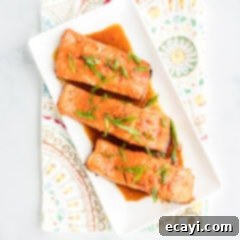
Maple Soy Salmon
IMPORTANT – There are often Frequently Asked Questions within the blog post that you may find helpful. Simply scroll back up to read them!
Print It
Pin It
Rate It
Save ItSaved!
Ingredients
- 2 lbs center cut salmon cut into 4 filets (approx. 8 oz each)
- 2 Tbsp olive oil
For the Maple Soy Marinade
- ½ cup soy sauce (low sodium recommended)
- ¾ cup pure maple syrup (not pancake syrup)
- ½ Tbsp garlic salt (or ½ tsp garlic powder + ¼ tsp salt)
- 1 tsp black pepper (freshly ground)
- 1 tsp red pepper flakes (adjust to taste for heat)
- 1 Tbsp minced garlic (fresh is best)
- green onion sliced for garnish, optional, or fresh parsley
Essential Equipment
-
13×9 baking dish
-
Oven-proof skillet (cast iron recommended)
-
Saucepan
-
Whisk
-
Instant-read thermometer (optional but recommended for accuracy)
Chef’s Notes & Pro Tips
- Achieving Perfect Doneness: To test your fillets for doneness, gently press your finger (or the tip of a knife if it’s too hot) onto the top center or thickest part of the fillet – if it begins to flake or separate easily, it is done cooking. Be careful not to overcook the fillets, as they will become dry and overly flaky. For precision, use an instant-read thermometer; salmon is perfectly finished when it reaches an internal temperature of 125-135°F (52-57°C) in the thickest part.
- Sauce Consistency: The thickness of your reduced glaze directly impacts the boldness of its flavor. If you prefer a thinner sauce that lightly coats the fish, reduce it for a shorter period. For a thicker, more intense glaze, simmer it longer until it achieves your desired consistency.
- Baking Dish Alternative: If you don’t have an oven-proof skillet, don’t worry! After searing, you can carefully transfer the salmon fillets to a regular casserole or baking dish to finish baking in the oven. Ensure the dish is lightly greased to prevent sticking.
- Presentation & Serving: We recommend serving each fillet on its own plate because the delightful maple-soy syrup causes the skin side to be quite sticky. This natural stickiness makes it remarkably easy for the fish to separate from the skin when eating. However, if you wish to present your fillets on a large platter, it’s best to lay a piece of waxed paper or parchment paper first to prevent sticking.
- Meal Pairing Ideas: This versatile salmon pairs beautifully over a bed of fluffy white or brown rice. Complement it with a side of vibrant roasted vegetables such as green beans, broccoli, asparagus, Brussels sprouts, or sweet potatoes. A fresh, crisp leafy dinner salad also makes for an excellent, lighter accompaniment.
- Leftover Creativity: Should you have any leftovers, store them in an airtight container in the refrigerator for up to 2 days. Cold, crumbled leftover salmon is fantastic when added to salads, pasta dishes, or even incorporated into fresh wraps for a quick and healthy meal.
Instructions
-
Preheat oven to 375°F (190°C).
-
In a 13×9 baking dish, combine soy sauce, maple syrup, garlic salt, pepper, red pepper flakes, and minced garlic. Whisk well to create the marinade.
-
Place salmon fillets, skin side up, into the marinade. Ensure they are coated. Marinate in the refrigerator for 30 minutes. Do not marinate for longer than 30 minutes.
-
Heat olive oil in an oven-proof skillet over medium-high heat until shimmering.
-
Remove fish from marinade (reserve marinade for sauce) and place skin side up in the hot skillet. Sear for 2-3 minutes until a crust forms.
-
Meanwhile, transfer the reserved marinade from the baking dish into a small saucepan. Set aside.
-
Turn fish over so it is skin side down in the skillet. Brush the flesh side of the fillets with some of the marinade from the saucepan to coat.
-
Transfer the skillet to the preheated oven and bake for 15-20 minutes, uncovered, or until salmon reaches desired doneness (125-135°F / 52-57°C internal temperature).
-
While salmon bakes, bring the marinade in the saucepan to a gentle boil over medium-high heat, stirring occasionally. Reduce heat to medium-low and simmer, stirring occasionally, until the marinade thickens into a glaze and coats the back of a spoon.
-
Remove salmon from the oven. Brush generously with the thickened maple soy glaze. Garnish with sliced green onions or fresh parsley, if desired, and serve immediately.
Nutrition Information
The recipes on this blog are tested with a conventional gas oven and gas stovetop. It’s important to note that some ovens, especially as they age, can cook and bake inconsistently. Using an inexpensive oven thermometer can assure you that your oven is truly heating to the proper temperature. If you use a toaster oven or countertop oven, please keep in mind that they may not distribute heat the same as a conventional full sized oven and you may need to adjust your cooking/baking times. In the case of recipes made with a pressure cooker, air fryer, slow cooker, or other appliance, a link to the appliances we use is listed within each respective recipe. For baking recipes where measurements are given by weight, please note that results may not be the same if cups are used instead, and we can’t guarantee success with that method.
